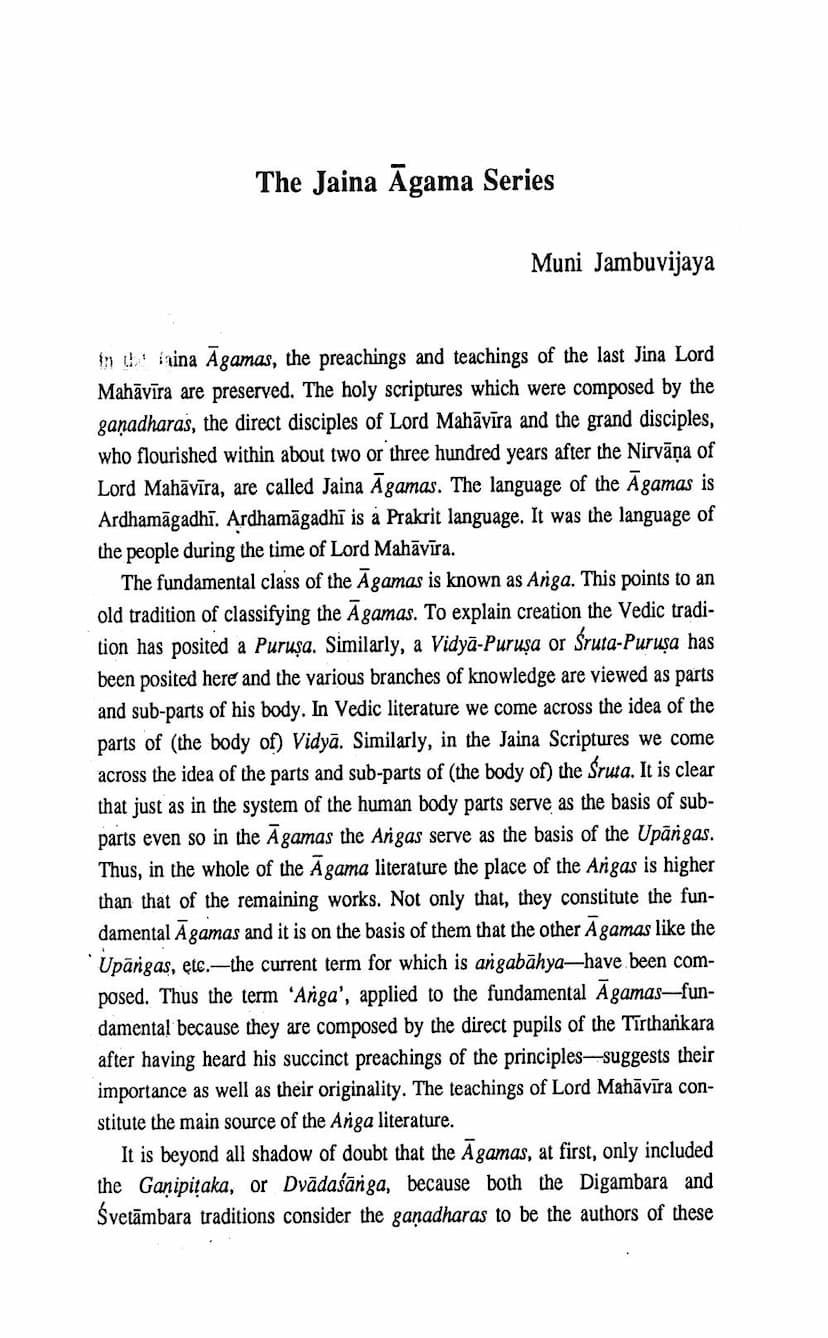Jaina Agama Series
Added to library: September 2, 2025

Summary
This document, "The Jaina Agama Series" by Muni Jambuvijaya, serves as an introduction to the Jaina Āgamas, which are the holy scriptures containing the teachings of Lord Mahāvīra. The text elaborates on the structure, classification, and historical development of these sacred texts.
Here's a comprehensive summary of the key points:
1. Definition and Origin of Jaina Āgamas:
- The Jaina Āgamas preserve the preachings and teachings of the last Jina, Lord Mahāvīra.
- They were composed by the ganadharas (direct disciples of Mahāvīra) and their grand-disciples within a few centuries after Mahāvīra's Nirvana.
- The original language of the Āgamas is Ardhamāgadhī, a Prakrit language spoken by the people during Mahāvīra's time.
2. Classification of Āgamas:
- Anga (Fundamental Āgamas):
- The fundamental class is known as Anga.
- This classification is metaphorically linked to the Vedic concept of a Vidyā-Purușa or Sruta-Purușa, where different branches of knowledge are seen as parts of his body. The Angas are considered the primary parts.
- The Angas are considered more important and original as they were composed by Mahāvīra's direct disciples based on his succinct preachings.
- Originally, the Āgamas comprised only the Ganipițaka or Dvādaśānga (Twelve Angas).
- Angabāhya (External Āgamas):
- Works composed by later disciples of the ganadharas were gradually included in the Āgama literature and are known as angabāhya (external to the Angas).
- This classification of Anga and angabāhya reflects the distinction between works by ganadharas and those by other authors.
- Both Digambara and Śvetāmbara traditions agree on including all Āgamas other than the Twelve Angas in the angabāhya category.
3. Historical Development and Lists of Angabāhya Works:
- The text traces the inclusion of various works into the angabāhya category over time, noting the difficulty in establishing a precise chronological order for these additions.
- Vācaka Umāsvāti's List: He enumerates several angabāhya works, including Sāmāyika, Caturvimšatistava, Vandanā, Pratikramana, Kāyavyutsarga, Pratyākhyāna, Daśavaikālika, Uttarādhyayana, Daśā, Kalpa-Vyavahāra, Nisītha, Rşibhāșita, etc. The "etc." suggests more works.
- Dhavalā Commentary: The author of the Dhavalā-tīkā lists fourteen angabāhya works.
- Jayadhavalā: This commentary applies the term prakīrņaka to these fourteen angabāhya works and provides their detailed contents.
- Combined Lists: The text identifies a total of eighteen commonly known angabāhya works based on these lists, including those that form the āvasyaka (six essential practices).
- Nandisūtra's Lists: The Nandisūtra mentions both utkālika angabāhya works (those studied at any time) and kālika angabāhya works (those studied at specific times). The text provides extensive lists for both categories.
- It's noted that many angabāhya works mentioned in older texts are now extinct.
4. Further Classifications of Āgamas:
- Kālika and Utkālika: The angabāhya works are further divided into kālika (studied at specific times) and utkālika (studied at any time). This classification is as old as the Anuyogadvārasūtra.
- Āvasyaka and Āvasyakavyatirikta: A classification emerges where angabāhya works are divided into āvasyaka (the six essential practices) and āvasyakavyatirikta (other than the āvasyaka). The Nandisūtra and Anuyogadvārasūtra present slightly different hierarchical arrangements of these classifications.
- Modern Śvetāmbara Classification: A more recent classification, prevalent in the modern Śvetāmbara tradition, categorizes Āgamas into six groups:
- Anga: The twelve fundamental scriptures.
- Upanga: Secondary texts.
- Cheda: Texts related to monastic discipline.
- Mūla: Foundational texts for learning.
- Prakīrņaka: Miscellaneous texts.
- Cūlikā: Appendages or supplementary texts (like Nandi and Anuyogadvāra).
5. Scholarly Efforts and Critical Editions:
- The text laments the lack of scholarly interest in Jaina Āgamas compared to Vedic and Buddhist texts, attributing it partly to the absence of good, accessible editions.
- It details the history of attempts to publish Jaina Āgamas, from early English translations to more critical editions.
- Notable scholars like Prof. Weber, Dr. Hermann Jacobi, Leumann, Hoernle, and Schubring are mentioned for their contributions to critical editing.
- The establishment of the Śrī Jaināgama Prakāśinī Samsad in 1943 by Muni Shri Punyavijayaji is highlighted as a significant effort towards a comprehensive critical edition of all Āgamas.
- The article outlines the six principles adopted for critically editing the texts and presents a detailed scheme for publishing the Āgamas in 17 volumes, categorizing them by Anga, Upanga, Chedasūtra, Mūlasūtra, Prakīrņaka, and Cūlikāsūtra.
- It mentions the progress of this publication project, with several volumes already edited and published by different scholars, including Muni Shri Jambuvijaya himself.
In essence, Muni Jambuvijaya's work provides a detailed roadmap to understanding the Jaina Āgamas, tracing their origins, internal structure, external classifications, and the ongoing scholarly efforts to preserve and disseminate these crucial religious texts.